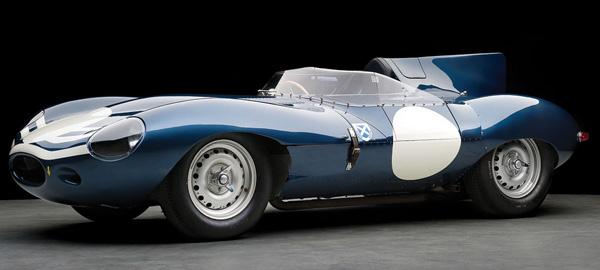|
The Most Beautiful Cars Ever Built |
|
|
1955 Jaguar D-Type |
|
|
Estimated Value: $6,300,000 285 bhp, 3,781 cc DOHC six-cylinder engine with wide-angle cylinder heads, four-speed synchromesh gearbox, independent front suspension with double wishbones and longitudinal torsion bars, live rear axle with rear trailing links and single transverse torsion bar, and four-wheel hydraulic disc brakes. Wheelbase: 2,300 mm Jaguar’s founding chairman, Sir William Lyons, understood that great styling and success in international racing sold cars. As such, the race to win, above all, was the gruelling 24 Hours of Le Mans. His phenomenal C-Type Jaguars, developed from the road going XK120, won Le Mans outright in 1951 and 1953. Jaguar was then under great pressure to come up with a new car to continue this record of success. The result was soon to become a legend. Late in 1953, Jaguar factory’s test driver, Norman Dewis, managed nearly 180 mph on the Jabbeke Highway in Belgium in a C/D-Type prototype, auguring well for the subsequent model D-Type’s chances in the seasons ahead. Whilst the C-Type Jaguar employed a strong triangulated tubular chassis construction, the D-Type was built around an all-new, riveted aluminium-magnesium alloy monocoque designed by Jaguar’s chief designer and brilliant aerodynamicist, Malcom Sayer. Having spent time with the Bristol Aeroplane Company studying aeronautics, Sayer employed techniques evolved in the aviation industry to perfect his advanced method of monocoque construction. He was one of the first designers to apply the principles of aerodynamics to cars, coincidentally creating one of the most beautiful forms of the era. Sayer famously went on, of course, to design the legendary Jaguar E-Type. The D-Type was smaller, five inches shorter, and more svelte than a C-Type. The two-seat cockpit was permanently divided by a thin body panel that had a snug right-hand-side opening for the driver, with a smaller opening on the “passenger” sid. A welded aluminium front sub-frame of square-section tubes, bolted to the monocoque, was used to mount the familiar seven main bearing, 3.4-litre Jaguar engine, which was now canted eight degrees from vertical to clear the low bonnet line. The adoption of dry-sump lubrication allowed the engine to drop a further three inches in the sub-frame to further reduce the frontal area. Equipped with three twin-choke Weber carburettors, the output was a healthy 250 horsepower.
|

